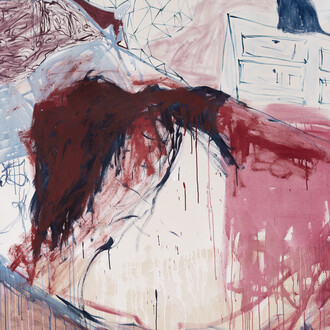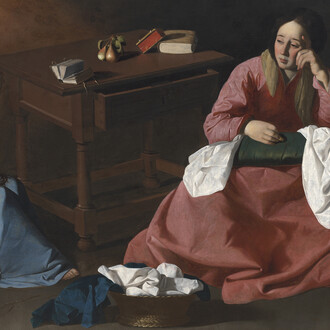Sharp suits, polished shoes, tightly knotted ties: in Zemba Luzamba's paintings, clothing is more than style - it is a language of freedom and resistance. The figures that Luzamba paints are sapeurs, members of the Congolese sub-culture known as Sape (the Société des Ambianceurs et des Persons Élégantes) that emerged in the 1960s and 70s when President Mobutu banned the wearing of Western-style suits in favour of the abacost, a lightweight suit which was traditionally worn without a tie. The abacost became closely associated with Mobutu's supporters, especially those who profited under his regime. To Luzamba and many Congolese today, the tailored suit continues to signal defiance and individuality.
While Sape culture remains a central motif throughout Luzamba's paintings, his interest lies equally in how meaning is shaped by body language and setting. Subtle details - how someone sits, or where - become clues to social status and personality. In this exhibition, for instance, we encounter two sapeurs seated in red leather armchairs within what appears to be a grand drawing room. Though both are elegantly dressed, their postures and positioning reveal a hierarchy: the man in the yellow jacket clearly holds the authority. Beside him stands a carved wooden stool, a traditional symbol of leadership and power, historically reserved for chiefs, elders and figures of influence.
Other works depicts only the legs and shoes of figures sitting in a line - on white plastic chairs, along a wall, in some kind of hall or domestic space. The titles hint at the scenarios - Casual, spectators and groomsmen - but even without them, we can infer the dynamics of the group and situation through gesture and stance. In Spectators, three pairs of shoes are planted firmly forward, their wearers relaxed yet assertive. One man leans back with legs spread wide, suggesting a quiet kind of power play. Who or what are they spectating? Are they watching for amusement or exerting pressure through their gaze? By contrast, in Casual, feet dangle and kick up, a newspaper is loosely rolled in one hand, a briefcase rests on another's knees: perhaps colleagues on a break, strangers at a bus stop or friends passing time.
As in all of Luzamba's works, these scenes resist fixed narratives, inviting us to imagine the stories behind the suits, where even the smallest gestures unravel the complexities of identity, status and power.
















